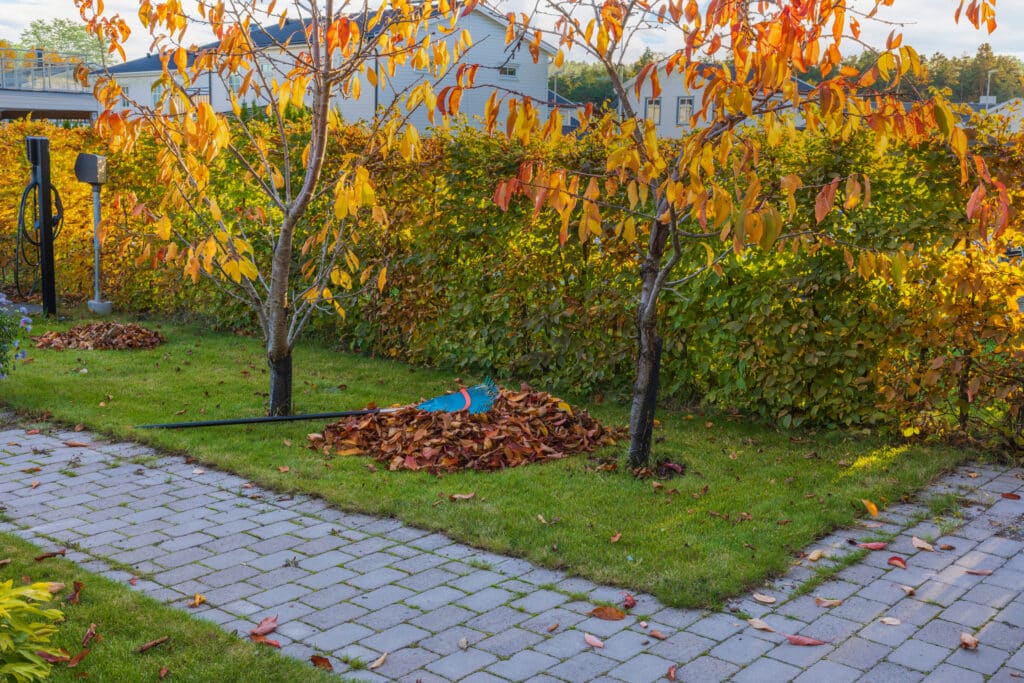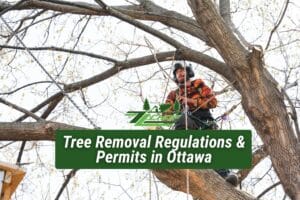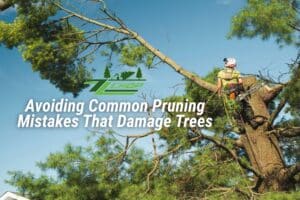Trees are more than just beautiful elements of our landscapes. They provide shade, clean the air, and add character to our properties. But when a tree shows signs of distress or disease, it can pose risks to your safety and your home.
Knowing how to identify if your tree is dying and understanding what to do about it ensures not only the health of your property but also the safety of your surroundings.
What does a Dying tree Look Like?
A dying tree often exhibits visible signs that indicate its health is severely declining. One of the first indicators is the presence of discolored or wilting leaves, which may turn yellow, brown, or fall off prematurely. Additionally, the tree may show reduced new growth, with branches appearing brittle or sparse compared to healthy counterparts.
Another common sign of a dying tree is damaged or decaying bark, which may peel away or reveal cracks and holes caused by pests or disease. Fungal growth or mushrooms near the base of the tree can also indicate root decay or internal rot. Recognizing these warning signs early is crucial for property owners to take action and prevent hazards, ensuring safety and the potential preservation of the tree.
Early signs your tree might be in trouble
Spotting the signs of a declining tree early can make the difference between saving it and needing to remove it entirely. Here’s what to look for:
Brittle or missing leaves
If your tree’s leaves appear sparse, discolored, or brittle when they should be healthy and vibrant (particularly during growth seasons), this could indicate the tree is under stress. Look out for unusual patterns like leaves only growing on certain branches or a premature loss of foliage.
Cracks and peeling bark
The bark of a healthy tree serves as a protective shell. If you notice it cracking, peeling, or falling off altogether, it’s often a sign of disease, decay, or pest infestation. Bark that sounds hollow when tapped is another red flag.
Dead branches
Broken or dead branches, often referred to as “widow-makers,” aren’t just a sign of poor tree health; they’re also a safety hazard. You can identify dead branches if they lack buds, foliage, or show visible rot.
Fungus growth
Mushrooms or fungus growing around the base of the trunk or along the branches can indicate internal decay. While not all fungi are problematic, large clusters often signal that the tree is weakening from the inside.
Leaning tree
A tree that suddenly leans to one side may have root damage, making it unstable and dangerous. Slight leaning over time may be due to natural growth, but an expert should inspect significant changes.
How to Know if a Tree is Dead or Diseased?
Determining whether a tree is dead or diseased is essential for safety, property aesthetics, and overall landscape health. Observing leaves, branches, trunk, and roots can provide clear signs of decline. Early detection helps prevent hazards and allows for timely treatment or removal of affected trees.
Leaf and Foliage Inspection
Unhealthy trees often display noticeable issues in their leaves and foliage, which are early indicators of stress or disease.
Signs of Leaf Discoloration
- Yellowing or browning leaves outside the normal season can indicate nutrient deficiency or disease.
- Spots, blotches, or unusual patterns may signal fungal or bacterial infections.
Premature Leaf Drop
- Leaves falling before their natural cycle is a common sign of stress.
- Sparse leaf growth compared to previous seasons suggests declining tree health.
Wilting and Curling
- Wilting, curled, or shriveled leaves indicate water stress or root damage.
- Consistent leaf deformities can be a symptom of pests or systemic disease.
Branch and Trunk Examination
The condition of branches and the trunk often reveals structural and health problems in a tree.
Dead or Brittle Branches
- Branches that snap easily or have no springiness are likely dead.
- Hanging or broken limbs can pose a safety hazard to nearby areas.
Bark Damage and Cracks
- Peeling, splitting, or cracked bark can expose the tree to pests and infection.
- Dark streaks, oozing sap, or fungal growth often indicate disease progression.
Structural Weakness
- Leaning trunks or unusual shapes may indicate internal decay.
- Regular monitoring of trunk stability helps prevent unexpected tree falls.
Root and Soil Health Check
Roots and surrounding soil provide essential nutrients and support; damage here often signals serious problems.
Exposed or Damaged Roots
- Roots sticking out above the soil or cut roots can stress the tree.
- Exposed roots are vulnerable to disease and reduce stability.
Fungal Growth and Soil Compaction
- Mushrooms or fungal bodies near roots often indicate decay.
- Compacted soil prevents water and nutrient absorption, weakening the tree.
Poor Drainage
- Waterlogged or overly dry soil affects root health.
- Maintaining optimal soil conditions ensures long-term tree vitality.
Professional Assessment
When signs of decline are unclear, consulting an arborist ensures proper diagnosis and intervention.
Tree Health Evaluation
- Certified arborists can identify diseases, infestations, and structural weaknesses.
- Accurate assessment prevents unnecessary removal and promotes recovery.
Recommended Treatments
- Treatments may include pruning, fertilization, pest control, or structural support.
- Early professional intervention improves tree survival and safety.
What can you do if your tree is dying?
Once you’ve identified potential issues, it’s time to take action. Here are your next steps to protect your tree and property:
Conduct a closer inspection
Take time to carefully inspect the base, trunk, branches, and leaves. Look for pests (such as burrowing insects), signs of disease, or structural damage. It’s a good idea to take photos to monitor changes over time.
Consult a tree care professional
An expert tree service, like ZZ Chop Tree Care in Ottawa, can provide a thorough assessment. Professionals will identify the root causes of your tree’s decline, whether it’s pests, disease, or soil issues. Their knowledge ensures that any necessary treatments or measures are carried out correctly.
Consider trimming or pruning
For trees that still have a chance of recovery, targeted trimming or pruning can remove dead or diseased branches. This gives the healthier parts of the tree more access to sunlight and nutrients, allowing it to recover.
Improve soil and water conditions
Sometimes, trees struggle due to environmental factors. Ensuring that your tree has well-draining, nutrient-rich soil and consistent moisture can help improve its health over time. You might also explore adding fertilizer or enhancing nearby soil conditions.
Remove the tree if it’s beyond saving
If a dying tree is at risk of falling or harming surrounding structures, removal might be the only option. While no one wants to say goodbye to a beloved tree, removing it safely can prevent larger issues down the road.
How to Identify Dead Trees?
Dead trees can pose safety hazards and affect the overall health of your landscape. Identifying them early helps prevent property damage and allows timely removal or treatment. Key indicators include unhealthy leaves, brittle branches, damaged bark, and unstable roots, all of which signal a tree may be dead or dying.
| Key Sign | Details | Tips / Indicators |
| Leaf and Foliage Condition | Dead trees often have no leaves, or leaves that are brown, brittle, or falling off at unusual times. | • Check for leaves out of season• Look for dry, curled, or spotted leaves• Observe sparse foliage compared to nearby healthy trees |
| Branch and Twig Health | Dead trees have brittle, dry, or hollow branches and twigs that break easily. | • Gently snap small branches to test flexibility• Look for dead ends on branches• Observe lack of new growth in spring |
| Bark and Trunk Appearance | Bark may peel, crack, or fall off; fungal growth, holes, or dark streaks may appear. | • Check for mushrooms or fungus at the base• Look for deep cracks or missing sections of bark• Inspect for insect infestations or boreholes |
| Root and Structural Stability | Roots may be decayed or exposed; tree may lean, wobble, or show signs of instability. | • Look for soft or spongy areas near the trunk base• Check for soil erosion exposing roots• Test stability by gently pushing trunk if safe to do so |
Why professional tree care matters
Taking care of your property’s trees isn’t just about aesthetics but about safety and long-term health. This is where reliable tree care services come into play.
At ZZ Chop Tree Care, we specialize in tree health assessments, trimming, and removal, ensuring your trees are well-maintained or safely removed if necessary. From emergency tree removal after a storm to regular maintenance, we’re here to help.
Conclusion Conclusion
Properly identifying a dying or dead tree is essential for maintaining a safe and healthy landscape. Early detection of signs such as discolored leaves, brittle branches, damaged bark, or unstable roots allows property owners to take timely action. Consulting a professional arborist ensures accurate diagnosis and effective treatment or removal if necessary.
Implementing corrective measures like pruning, improving soil conditions, or pest management can help salvage trees showing signs of stress. In cases where trees are beyond saving, safe removal prevents potential hazards to people and property. Prioritizing tree health through monitoring, maintenance, and professional care supports the long-term beauty, safety, and environmental benefits of your landscape.
FAQS
1. Can a dying tree recover if treated early?
Yes, many trees showing early signs of stress can recover with proper care such as pruning, fertilization, pest management, and improved soil conditions. Early intervention significantly increases the chances of survival.
2. How often should I inspect my trees for health issues?
Tree inspections should be done at least twice a year, ideally during spring and fall, to identify signs of disease, pests, or structural damage before they worsen.
3. What are the main causes of tree decline?
Tree decline can result from environmental stress, pests, diseases, poor soil conditions, or damage from storms and construction activities. Identifying the root cause helps determine the correct treatment.
4. Is it dangerous to leave a dying tree in my yard?
Yes, dying or dead trees can pose serious risks, including falling branches, trunk collapse, and attracting pests that may spread to other plants or structures.
5. How can soil conditions affect tree health?
Poor soil conditions, such as compaction, poor drainage, or nutrient deficiencies, can weaken roots and stress trees, making them more susceptible to disease and decline.




